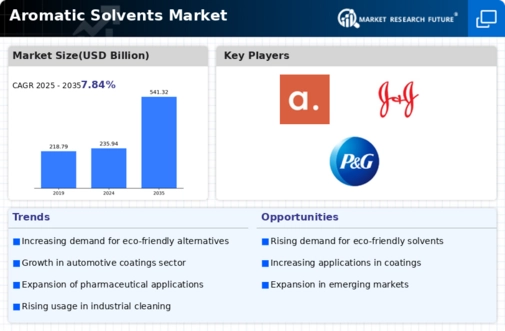Top Industry Leaders in the Aromatic Solvents Market

The aromatic solvents market, valued at an estimated US$ 6.2 billion in 2023, holds a crucial position in various industries, from paints and coatings to adhesives and printing inks. However, its landscape is a dynamic tapestry of established players, emerging contenders, and evolving trends, making competition fierce and multifaceted. Let's delve into this intriguing realm, understanding the strategies, factors influencing market share, noteworthy industry news, and recent developments shaping the future of aromatic solvents.
Strategies Adopted by Market Leaders:
1. Product Diversification: Major players like ExxonMobil, BASF, and Dow are expanding their portfolios beyond traditional solvents, offering bio-based and high-purity options to cater to evolving environmental regulations and customer preferences.
2. Backward Integration: To secure raw material supply and mitigate price fluctuations, giants like Chevron Philips are integrating upstream into crude oil production and refining.
3. Geographical Expansion: Emerging markets in Asia Pacific and Latin America present lucrative opportunities. Companies like Cargill are strengthening their presence in these regions through acquisitions and partnerships.
4. Technological Innovation: R&D is crucial for developing sustainable and efficient alternatives. ExxonMobil's research on low-aromatic solvents for paints exemplifies this focus.
5. Collaborations and Alliances: Strategic partnerships with downstream users in industries like automotive and construction can create a win-win situation, optimizing supply chains and enhancing market penetration.
Factors Influencing Market Share:
1. Raw Material Prices: Fluctuations in crude oil prices directly impact production costs and solvent pricing, affecting competitiveness.
2. Environmental Regulations: Stringent regulations on VOC emissions and waste disposal are pushing manufacturers towards eco-friendly solvents, benefiting companies with strong bio-based offerings.
3. Regional Demand: Growth in construction and infrastructure projects in developing economies fuels demand for paints and coatings, driving solvent consumption.
4. Technological Advancements: Development of green alternatives like water-based systems and solventless technologies pose a challenge to traditional aromatic solvents.
5. Pricing Dynamics: Intense competition can lead to price wars, squeezing profit margins and putting pressure on smaller players.
Key Companies in the Aromatic Solvents market include
- Exxon Mobil Corporation (U.S.)
- Celanese Corporation (U.S.)
- Royal Dutch Shell plc (U.K)
- Eastman Chemical Company (U.S.)
- BASF SE (Germany)
- LyondellBasell Industries Holdings B.V (Netherland)
- Chevron Phillips Chemical Company LLC (U.S)
- Honeywell International Inc (U.S)
Recent Developments:
February 2021: Honeywell, one of the main synthetic makers on the planet, says that Hengyi Industries will send bleeding edge aromatics advances from the Honeywell UOP at the petrochemical unit in Pulau Muara Besar, Brunei. The creation unit will handle near 200,000 barrels in a day. The heightening paraxylene request all over Asia is convincing organizations to spend altogether on advances that convert raw petroleum to petrochemicals.
August 2023: The European Chemicals Agency (ECHA) proposed new restrictions on the use of toluene and xylene, two of the most common aromatic solvents. The proposed restrictions are designed to reduce human exposure to these chemicals, which are known to be harmful to health. The restrictions are expected to be finalized in 2024.
February 2023: Dow announced the acquisition of the assets of Aprotec, a UK-based supplier of aprotic solvents. The acquisition will strengthen Dow's position in the aprotic solvents market, and it is expected to help the company to meet the growing demand for aprotic solvents in a variety of applications.
March 2023: Eastman Chemical launched its new line of high-performance aprotic solvents for use in the pharmaceutical industry. The solvents are designed to meet the demanding requirements of the pharmaceutical industry, such as high purity and low toxicity.

